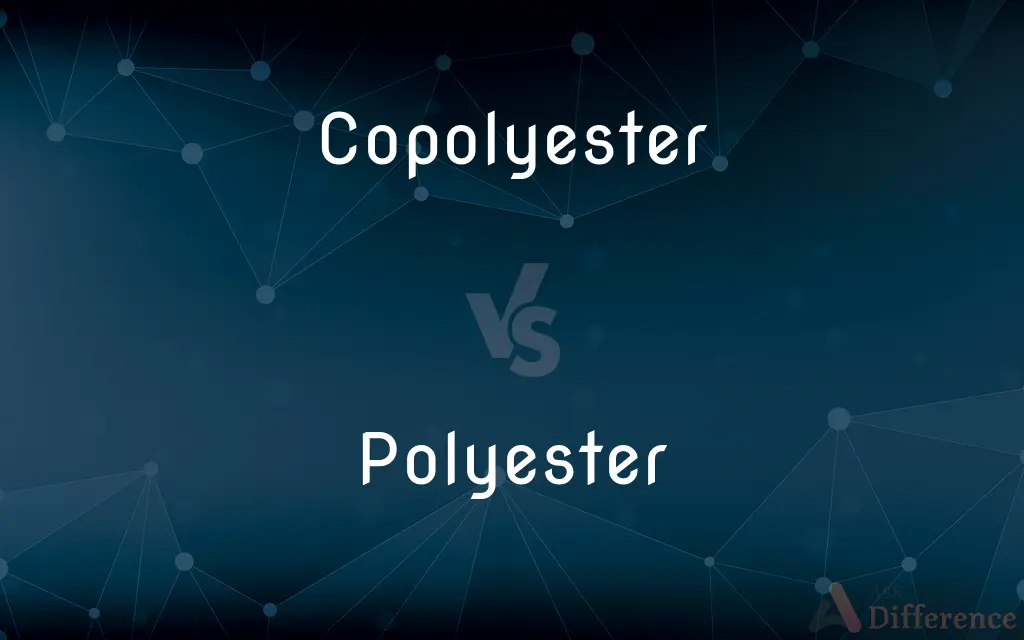Copolyester vs. Polyester — What's the Difference?
By Fiza Rafique & Urooj Arif — Updated on April 7, 2024
Copolyester is a type of polyester with added co-monomers for flexibility, whereas polyester is a broad category of polymers known for strength and durability.

Difference Between Copolyester and Polyester
Table of Contents
ADVERTISEMENT
Key Differences
Copolyester is a variant of polyester that incorporates different types of monomers in its polymer chain, which enhances its flexibility and chemical resistance. Whereas, polyester typically refers to polyethylene terephthalate (PET), known for its strength, durability, and use in textiles and packaging.
Copolyester materials are designed to offer better flexibility and softer feel compared to traditional polyesters, making them ideal for specific applications like medical devices and flexible packaging. On the other hand, polyester’s rigidity and resistance to environmental factors make it suitable for clothing, containers, and industrial uses.
The chemical structure of copolyesters includes co-monomers that interrupt the regularity of the polyester chain, thus lowering the material’s melting point and increasing its flexibility. In contrast, the polyester structure is more uniform, leading to higher melting points and rigidity.
Copolyester products often exhibit enhanced transparency and gloss, beneficial for packaging applications where aesthetic appearance is important. Polyester, while also capable of being transparent, is primarily valued for its mechanical properties and thermal resistance.
In environmental terms, both copolyesters and polyesters can be recycled, but copolyesters may require more specific recycling processes due to their unique chemical compositions. Polyesters, especially PET, have well-established recycling streams worldwide.
ADVERTISEMENT
Comparison Chart
Composition
Includes co-monomers for flexibility
Primarily polyethylene terephthalate (PET)
Flexibility
More flexible
Less flexible
Applications
Medical devices, flexible packaging
Clothing, containers, industrial uses
Chemical Resistance
Higher due to varied monomers
Standard resistance
Recycling
Possible, but may require specific processes
Widely recycled
Compare with Definitions
Copolyester
The ability of a material to maintain integrity upon exposure to chemicals.
The lab containers crafted from copolyester resisted the harsh chemicals remarkably well.
Polyester
A category of polymers used extensively in textiles and plastics, known for its durability.
The new line of jackets is made from recycled polyester.
Copolyester
A characteristic of materials that allows them to bend without breaking.
Copolyester's flexibility makes it ideal for use in products requiring a soft touch.
Polyester
The ability of a material to resist changes when exposed to high temperatures.
The polyester fabric retained its shape even after being exposed to the sun for hours.
Copolyester
The method of converting waste materials into reusable materials.
The company developed a new recycling process specifically for copolyester products.
Polyester
The stiffness of a material and its resistance to bending.
The rigidity of polyester ensures that the storage boxes are sturdy and durable.
Copolyester
A type of polyester that includes additional co-monomers to improve flexibility.
The water bottle made of copolyester was surprisingly soft and durable.
Polyester
The strength of a material and its ability to withstand wear, pressure, or damage.
Polyester’s durability makes it a favorite for outdoor clothing.
Copolyester
The quality of a material that allows light to pass through it.
The copolyester packaging's transparency highlighted the product's features.
Polyester
The systems in place for collecting, processing, and repurposing waste materials.
Polyester bottles are commonly processed through established recycling streams.
Copolyester
Copolyester forms when modifications are made to polyesters, which are combinations of diacids and diols. For example, by introducing other diacids, such as isophthalic acid (IPA), or other diols, such as cyclohexane dimethanol (CHDM) to the polyester polyethylene terephthalate (PET), the material becomes a copolyester due to its comonomer content.Copolyesters retain their strength, clarity, and other mechanical properties even when exposed to a variety of chemicals that typically affect other materials, such as polycarbonates.
Polyester
Polyester is a category of polymers that contain the ester functional group in every repeat unit of their main chain. As a specific material, it most commonly refers to a type called polyethylene terephthalate (PET).
Copolyester
A polyester that has been modified by the addition of other chemicals.
Polyester
A synthetic resin in which the polymer units are linked by ester groups, used chiefly to make synthetic textile fibres.
Polyester
Any of numerous synthetic polymers produced chiefly by reaction of dicarboxylic acids with dihydric alcohols and used primarily as light, strong, weather-resistant resins in boat hulls, textile fibers, adhesives, and molded parts.
Polyester
A wrinkle-resistant fabric of fibers made from any of these resins.
Polyester
Any polymer whose monomers are linked together by ester bonds
Polyester
A material or fabric made from polyester polymer
Polyester
Of, or consisting of polyesters
Polyester
Any of numerous synthetic resins; they are light and strong and weather resistant
Polyester
A complex ester used for making fibers or resins or plastics or as a plasticizer
Polyester
Any of a large class of synthetic fabrics
Common Curiosities
What makes copolyester different from polyester?
Copolyester includes co-monomers for added flexibility, whereas polyester is known for its durability and rigidity.
Can both copolyester and polyester be recycled?
Yes, both can be recycled, but copolyester may require specific recycling processes.
Which is more suitable for clothing, copolyester or polyester?
Polyester is more commonly used in clothing due to its durability and ease of care.
Can copolyester be used for food packaging?
Yes, its flexibility and chemical resistance make copolyester suitable for food packaging.
What are the environmental impacts of copolyester and polyester?
Both have environmental impacts, especially if not recycled properly, but efforts are ongoing to improve their recyclability.
Can the transparency of copolyester be a deciding factor in its use?
Yes, for packaging applications, transparency can highlight product features attractively.
Do copolyesters offer better chemical resistance than polyesters?
Yes, the varied monomers in copolyesters can provide enhanced chemical resistance.
Are all polyesters equally flexible?
No, flexibility varies, with copolyesters being more flexible than traditional polyesters.
Are copolyesters more expensive than polyesters?
Generally, copolyesters can be more expensive due to their specialized composition and properties.
Is polyester water-resistant?
Yes, polyester is inherently water-resistant, which makes it suitable for outdoor wear.
How does the addition of co-monomers affect copolyester properties?
Co-monomers increase flexibility, lower the melting point, and can enhance chemical resistance.
How does the cost of recycling affect the use of copolyester and polyester?
The cost can influence usage, especially if recycling processes are complex or costly.
Why is rigidity an important feature for some polyester applications?
Rigidity ensures structural stability in industrial and packaging applications.
What makes polyester popular in the textile industry?
Its durability, ease of care, and resistance to shrinking and stretching make it popular.
What roles do polyesters play in sustainability?
Through recycling and the use of recycled polyester, they contribute to sustainability efforts.
Share Your Discovery

Previous Comparison
Subsidy vs. Subvention
Next Comparison
Histogram vs. PictogramAuthor Spotlight
Written by
Fiza RafiqueFiza Rafique is a skilled content writer at AskDifference.com, where she meticulously refines and enhances written pieces. Drawing from her vast editorial expertise, Fiza ensures clarity, accuracy, and precision in every article. Passionate about language, she continually seeks to elevate the quality of content for readers worldwide.
Co-written by
Urooj ArifUrooj is a skilled content writer at Ask Difference, known for her exceptional ability to simplify complex topics into engaging and informative content. With a passion for research and a flair for clear, concise writing, she consistently delivers articles that resonate with our diverse audience.
















































